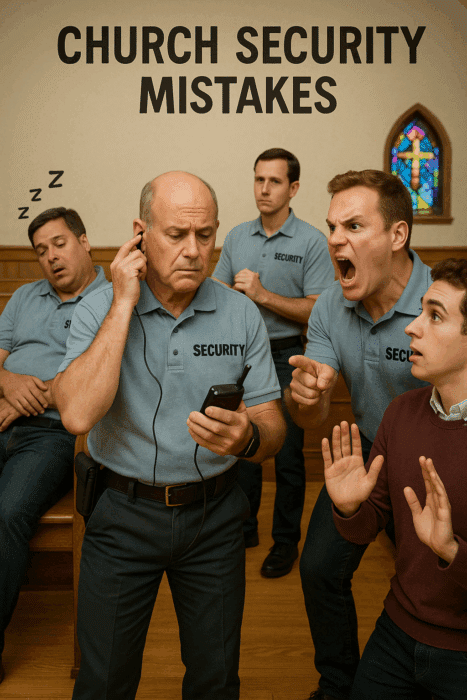Tips for Church Security Teams
Let me talk to you straight. We’re living in a broken world. Evil is real, and it doesn’t care that you’re in a church. Your congregation isn’t immune because you’ve got a worship band and coffee in the lobby. The mission is this: protecting the flock. Period.
But when I step into churches around the country—many with security teams—I keep seeing the same tactical failures repeated over and over. And in a fight, repeated failure is how people get hurt. Or worse.
Here are the four most common—and most dangerous—mistakes church security teams make, and essential effective tips for fixing them.
- Obsessing Over the Active Shooter Scenario
Let’s just get this out of the way: yes, you need to be prepared for the active killer. It’s the nightmare scenario. You don’t rise to the occasion—you fall to your level of training. But too many teams treat that one scenario like it’s the only threat.
Statistically? It’s not. What’s more likely: someone having a seizure in the sanctuary, a violent ex showing up during child pick-up, or a full-blown gunfight in the pews?
Exactly.
If you’re building your entire team around an event that probably won’t happen, you’re leaving real vulnerabilities wide open. Don’t be foolish. Prepare for the worst—but train for what’s most likely. Mental health disruptions, medical emergencies, disturbances in the parking lot—that’s the battlefield you’ll probably be on.
- Too Many Open Doors — Literally
Churches love being “open.” Great. Be open-hearted, not wide open to attack.
If you’ve got six or seven unlocked entrances on a Sunday morning, you’ve already lost the fight. You can’t defend what you can’t control. Lock ‘em down. Funnel all entry through one or two access points, and put a trained, alert guardian at each.
This isn’t about being unwelcoming—it’s about being ready. Your church is a soft target by default. Harden it with awareness and smart entry control. And no, fire codes aren’t an excuse. You can restrict access from the outside without blocking exits in an emergency.
- Complacency on Post
Let’s talk about team discipline. If you’ve got a guy scrolling Instagram at the back door during service, he’s not on a security team—he’s on a coffee break. And when evil walks through that door, coffee breaks kill people.
This is a serious job. You’re not just a greeter with a radio. You’re a protector. A sheepdog. Act like it. That means situational awareness, post integrity, and a warrior mindset.
Team leaders—build that mindset in your volunteers. Cast vision. Train hard. Praise commitment and correct sloppiness. This is a mission, not a ministry for the half-interested.
- No Real Training
Let me say this loud: If your security team isn’t training regularly, you don’t have a security team. You have a group of warm bodies.
Your team needs reps. Movement drills. Communication plans. Medical training. De-escalation skills. Even just a 30-minute video on mental health response is better than nothing.
Use what you’ve got—local law enforcement, online resources, medical professionals in your congregation. But do something. No one rises to the occasion. We all default to training. If you’re not training, you’re gambling with lives.
Final Word
This isn’t paranoia. It’s preparation. Evil exists. Denial doesn’t defeat it—preparedness does. Whether your church has 5,000 people or 50, if you’ve got a team guarding the flock, you better lead like lives depend on it.
Because someday, they might.
Train hard. Stay alert. Love deep. Be dangerous to evil.

